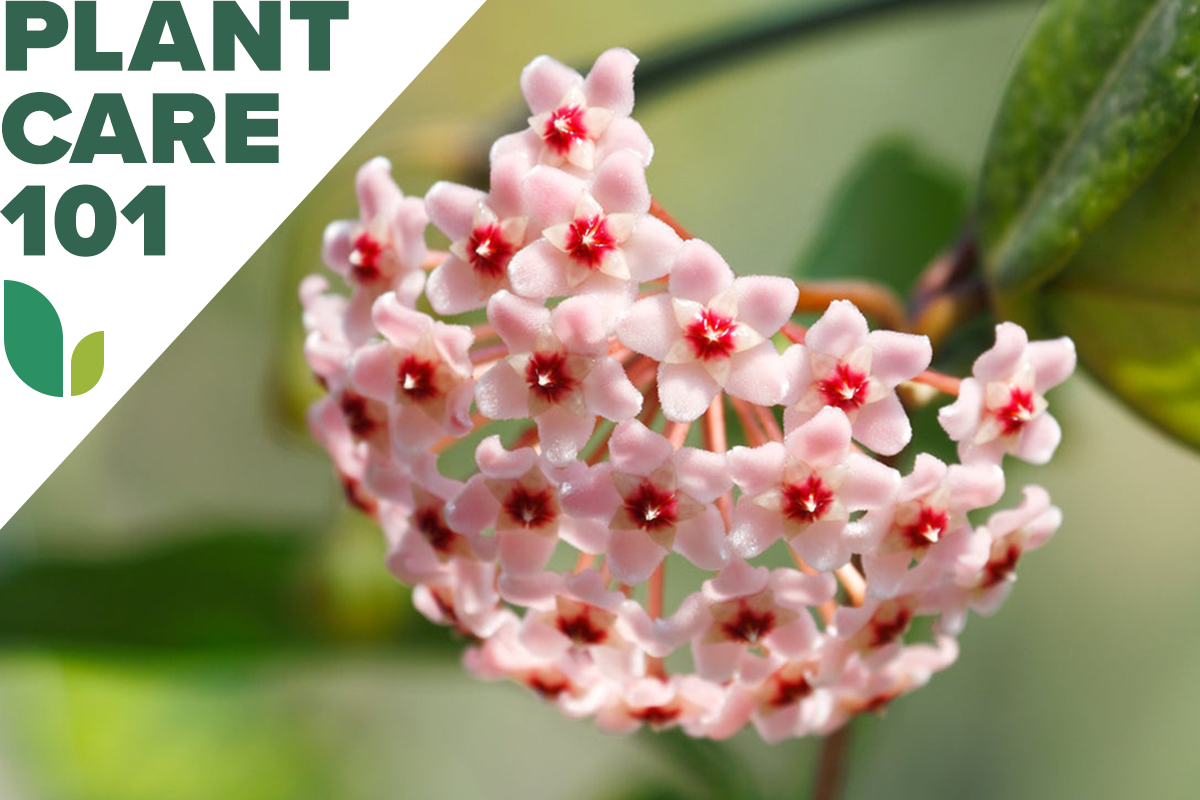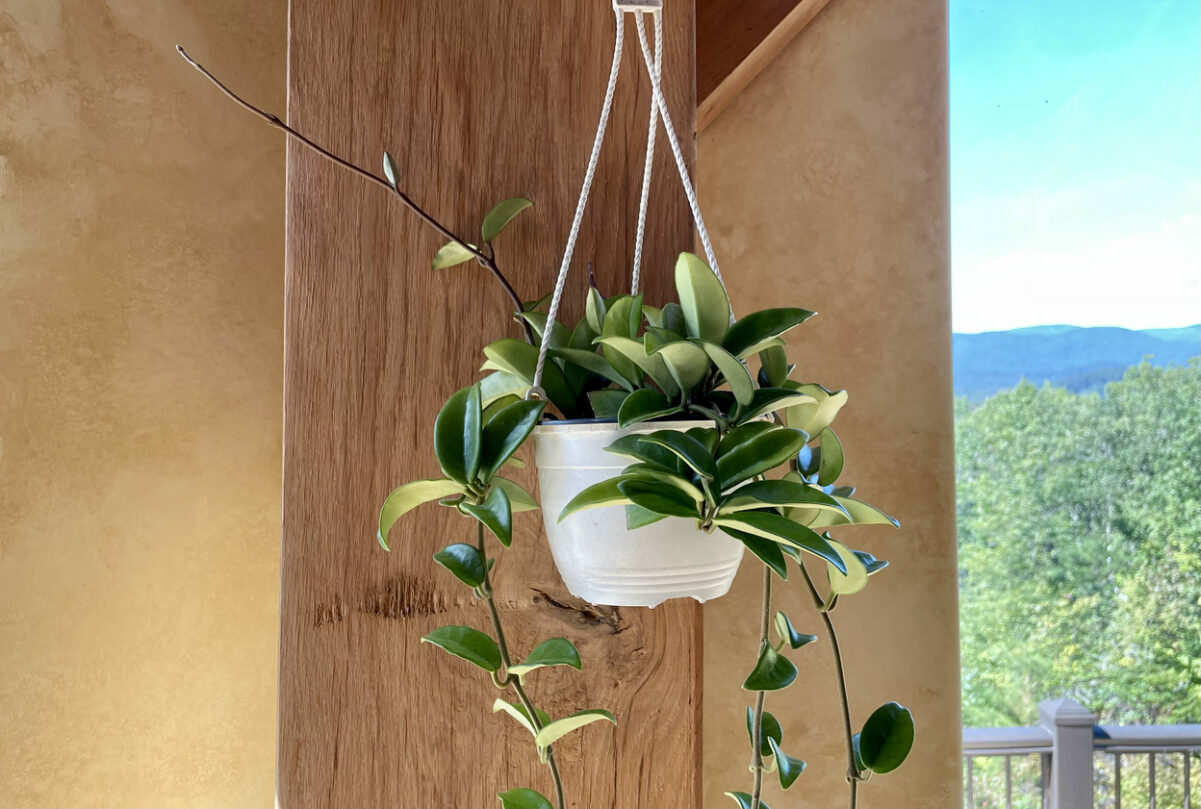

We may earn revenue from the products available on this page and participate in affiliate programs. Learn More ›
Hoya plant care is easy, since the vining succulent tolerates low light and intermittent watering with equanimity, unlike many other tropical species. However, as generations of gardeners have discovered, getting hoya to bloom can be a different matter altogether. If you want this plant to produce its clusters of waxy star-upon-star blooms, you might need to wait until the stars align. Or you can follow some of our hints for flower forcing and hope they get you the whole ball of wax!
Hoya Plant Care at a Glance
Common Name: Hoya, wax plant, porcelain flower
Scientific Name: Hoya spp.
Soil: Cactus and succulent potting mix
Light: Bright indirect light or partial sun
Water: Low
Food: Balanced or high-phosphorus fertilizer
Temperature and Humidity: Warm, cool winters, moderate humidity
Propagation: Tip cuttings
Safety: Nontoxic
Hoya Plant Characteristics
Although it has a succulent appearance, hoya originated in rain forests rather than deserts. A member of the milkweed family (to which its blooms bear some resemblance), the evergreen vine scrambles up and dangles from trees beneath the rain forest canopy in Southeast Asia, Australia, and New Guinea.
Its thick leaves vary, according to species, from oval to lance-like to heart-shaped, with some even taking on a contorted appearance. The long-lasting fragrant flowers appear in clusters of 10 to 30 blooms, each one resembling a waxy star positioned atop another waxy star or circle.
Most species, including the common Hoya carnosa, flower during spring or summer, although there are some autumn and winter bloomers, too. Even when using the best hoya care practices, though, a plant may take 3 or more years to mature to “stardom.”
RELATED: 20 Flowering Houseplants That Will Add Beauty to Your Home
Types of Hoya
- Hoya carnosa is the most common species and has fleshy leaves up to 4 inches long and red-centered white blooms.
- Hoya deykeae offers unusual pale-green heart-shaped leaves with shallow lobes and darker green veins and is accompanied by yellow and white flowers.
- Hoya finlaysonii also features dark-veined leaves as described above, and this species’ white blooms are tinged with maroon.
- Hoya memoria’s species name means “memory,” and the plant is memorable for its speckled leaves backing pink and red flowers.
- Hoya nicholsoniae often displays 4- to 6-inch red-tinged leaves along with yellow and white blooms, although this hoya type can vary.
- Hoya vitellinoides boasts large, dark-veined leaves and offers less showy yellow and white flowers.

Selecting Soil for Hoya Plants
As with most epiphytic types, this plant can develop root rot when kept too soggy. Provide it with a “soil” medium that drains freely, such as a cactus and succulent mix or a combination of one part standard potting mix, one part orchid mix, and one part perlite.
The pot you use should have drainage holes and be no more than 1 or 2 inches wider than the plant’s root ball, since hoya blooms best when kept a bit root-bound. For that reason, avoid repotting it until a move is absolutely necessary, at which point you should move it into an only slightly larger container.
The Right Light
Hoya prefers either bright indirect light or sunlight for no more than 2 to 6 hours per day. If you choose the sunny option, place your plant on an east- or west-facing windowsill rather than a south-facing one so that it receives rays only during the morning or late afternoon rather than at midday, when direct sun might burn its leaves.
Small hoya plants also can thrive beneath grow lights set to run for 12 to 16 hours per day. In that case, they might continue to vine rather than going dormant during the winter months, depending on how long an artificial day you have provided for them.

Watering Hoyas
During the spring and summer months, water your hoya after the top third or so of its soil has dried out but before the mix is parched all the way down—perhaps once per week, but that can vary with conditions. Irrigate it thoroughly enough that water runs from the drainage holes into the plant saucer, then discard the excess.
In autumn and winter, cut back the watering to about once every 2 weeks. Some sources recommend 1 month without water during midwinter to spur the plant into blooming in spring. At any rate, never leave the plant sitting in water, such as in a container without drainage holes.
RELATED: These Are the Most Popular Houseplants in America
Fertilizing Hoya Plants
Hoyas don’t require huge amounts of nutrients, which might encourage them to make more foliage rather than flowers. During most of the year, therefore, fertilize your plant only once per month with a balanced plant food, following the directions on the label. If you prefer, you can feed the hoya once a week instead, but—in that case—use only ¼ of the amount recommended for monthly feeding.
To help jolt your plant into blooming, switch to a high-phosphorus bloom-boosting type of plant food applied once every 2 weeks during its heaviest flowering period, which will be from April through June for most hoyas. Then, switch back to the balanced fertilizer until the end of autumn. Don’t feed your plant during its winter dormant period.
Setting the Temperature and Humidity
Hoya prefers temperatures between 70 and 75 degrees Fahrenheit during the day, dropping to 60 to 65 degrees at night. If your plant is one of the species that originated in a mountainous area like the Himalayas, place it in a cooler position during winter where the temperature remains between 55 and 60 degrees Fahrenheit. This may encourage it to bloom the following spring.
Despite its succulent appearance, hoya does appreciate humidity, so mist the plant with rainwater or spring water at least a couple of times per week. However, don’t mist it when the plant is in bloom.
Propagating Hoyas
To propagate a hoya, take a cutting that has two or three leaf nodes on it. Remove the leaves from the lowest node and dip that node in rooting powder or liquid. Insert it into a pot of damp and sterile soil—such as seed-starting mix—preferably so that the node is just at soil level or not too far beneath that surface. The cutting should root in 3 to 4 weeks, but it may take another month to begin putting out new growth.
Alternatively, you can root a cutting from a strand that still is attached to the mother plant by pinning that “rope” down in an adjacent pot of damp mix so that one or more of the leaf nodes is pressed into the soil. However, avoid taking leaf cuttings. Although hoya leaves can root on their own, they often prove incapable of putting out any new growth afterward.
RELATED: It’s Not Me, It’s You: The 15 Toughest Houseplants to Keep Alive

Safety Considerations
Hoya plants are considered nontoxic to pets and people, but they may be dangerous to your furnishings since the flowers drip a sticky nectar. For this reason, you’ll want to keep the plants in an easy-to-clean location—especially when they are blooming.
Once your hoya finally begins making buds, keep them safe by refraining from moving the plant to a different location, which could cause those buds to drop. You can also keep future flowers safe by leaving the plant’s peduncles (aka flowering spurs) in place after the blooms fade. A hoya peduncle is the short stem that holds a flower cluster and can produce new clusters in subsequent years.
Potential Pests and Diseases
Don’t become alarmed if your plant makes leafless vines when it begins to grow in spring. Those are entirely natural and will produce leaves eventually.
However, you’ll want to check for root rot should the leaves closest to your plant’s base begin to turn yellow or black and drop off. If the roots themselves look dark and mushy, you’ll need to cut away the rot, repot the plant in fresh potting mix, and reduce the amount you water it.
Although not usually attacked by insects, hoya may suffer from them–especially mealybugs–if kept too warm during winter. You can dispatch mealybugs with a cotton swab and rubbing alcohol.

FAQs About Hoya Plant Care
If you need hasty Hoya carnosa care hints for the plant bequeathed to you by a relative, or if you’re looking for prompt pointers on newer, rarer hoya species, consult the answers to frequently asked questions below.
No. It can thrive in bright indirect light, but it also does well in partial sun from an east- or west-facing window.
Yes, hoyas enjoy being misted, but avoid getting the flowers wet. Use distilled water to avoid spotting the waxy leaves.
Provide a location for your hoya with some bright light and cool conditions during winter. Give it high-phosphorus plant fertilizer in spring.
Hoyas come in both vining types—suitable for a pot with a trellis—and cascading types that are ideal for hanging baskets.
Water your plant about once a week during summer and once every 2 weeks during winter.
Yellowing lower leaves can be a sign of root rot, which is usually caused by overwatering.
Hoyas prefer days at 70 to 75 degrees Fahrenheit and nights at 60 to 65 degrees, but they can tolerate any temperatures between 55 and 85 degrees.
Looking for more low-maintenance houseplants? Check out our guides on caring for air plant, jade plant, and snake plant.
